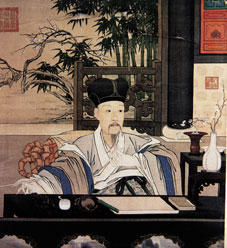Human Flower Project
Tuesday, July 26, 2005
Peony, Plum or Four Gentlemen?
In China, there’s old complexity and new urgency about picking a national flower.
 Peony, by Yun Shouping
Peony, by Yun Shouping
(perhaps China’s national flower)
Image: Dr. Kristi Siegel
When it suits them, Europeans and Americans dust off the Victorian “language of flowers” and assign meanings to blossoms. In China, codebooks aren’t required. From what we can tell, plants and flowers are still freighted with significance in China, part of popular culture. Most anyone could tell you that a pine tree stands for self-discipline, a peony means wealth.
Where flowers are more than ornamental, decisions about them are worth deliberation, even haggling. And so it goes in China. People’s Daily reports that 62 members of the national academies of Science and Engineering have been working hard to select a national flower. “With the 2008 Olympic and 2010 Shanghai World Expos drawing near, it is imminent to solve the problem, and it is time to end the debate.”
Today’s story suggests that the team of experts will recommend two flowers, the plum and the tree peony. “Tree peony has been popular in China since the 7th century and represents good fortune, love and prosperity and is the symbol of material world.
“The plum blossom is one of the few flowers that blossoms in winter. Experts say plum blossom symbolises the unyielding Chinese spirit that never bows to coldness and is the symbol of the spiritual world.”
It’s not often a nation faces an overt and public choice between the material and the spiritual, or, as China seems poised to do, dares to pick both. The experts realize that choosing more than one flower may dilute the potency of either emblem.
 Emperor Qian Long (1736-1795)
Emperor Qian Long (1736-1795)
with plum blossoms and bamboo
Image: Chinese Embassy of Nepal
Though the Chinese government didn’t ask us, we favor another idea that’s been proposed: to choose China’s four “noble flowers,” sometimes referred to as the “Four Gentlemen.” Traditionally, plum, orchid, bamboo and chrysanthemum have been emblems of the four seasons, winter, spring, summer, autumn, each with its particular weaknesses and strengths. The four noble flowers are everywhere in Chinese art; they even appear on the tiles of Mah Jong. Rather than a logo, convenient for plastering on the Olympic program, they communicate something truer and more interesting—about the variation within China’s complex society and the ever-changing requirements of being an international citizen.




